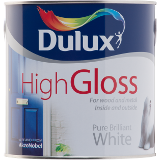Good to see you!
Welcome to Dulux
Terms & Conditions
Registration complete
Successfully registered, please login
Registration complete
Forgotten your password?
Please enter email address associated to your account
Change Password
Password changed successfully.
Request sent!
Delete Account

Dulux High Gloss
-
Finish Gloss
-
Coverage up to 18m²/L
-
Drying Time Touch Dry: 4-6 Hours
Recoatable: 16-24 Hours -
Coats 2
-
HIGH COLOUR DURABILITY
-
HIGH GLOSS FINISH
Product Description
Application Description
Health & Safety
Tips & Advice
-
1. Preparing the SurfacesTo get the best results with Dulux High Gloss make sure surfaces to be painted are sound, clean and dry (new surfaces particularly must be fully dry).
Remove all loose and defective paint. Special precautions should be taken during surface preparation of pre-1960s paint surfaces over wood and metal as they may contain harmful lead.
Where necessary, wash the surface to remove dirt, grease and powdery or dusty residues. Rinse with clean water and allow to dry. Seal surfaces that remain powdery after thorough preparation with an appropriate plaster sealer.
Where necessary, rub down and then wipe off with a damp, lint free cloth to avoid dust.
Any surface defects should be filled with the appropriate Polycell Polyfilla. -
2. After useCleaning After Final Use- Cleaning your brushes and rollers immediately after their final use ensures they can be reused for multiple projects, saving you money and reducing waste. Cleaning- 1. Remove Excess Paint- Scrape off excess paint into container for future projects. 2. Use Paint Thinner-- Use a paint thinner to clean brushes and rollers. 3. Reuse Paint Thinner- Allow the paint solids to settle and reuse the thinner by pouring the clear liquid into another container. Responsible Disposal- Dispose of the remaining solids and used thinner at a hazardous waste facility. Do not pour any solvent-based paint, paint thinner or wash water down the drain or onto the ground. Do not flush paint down the drain, including when cleaning painting tools
-
3. StoringStoring & Responsible Disposal Do not use or store paint in extreme temperatures and protect from frost. Whenever possible, reuse, recycle, or donate leftover paint. Find local services at mywaste.ie or consider advertising paint locally—many good causes need it to brighten community spaces. Dispose Responsibly- Never pour paint or waste washings down drains or sinks. Follow instructions at mywaste.ie to recycle empty packs. Reuse Roller Cages- Remove sleeves and store cages in a dry, dust-free place. If brushes or sleeves cannot be cleaned or reused, dispose of them in general waste to avoid recycling issues. Paint Washings- Collect used brush cleaner in a container; don't pour it into drains or on the ground. Let solids settle, pour off clear liquid into another container for reuse or disposal. Dispose of remaining solids and used cleaner at a hazardous waste facility. Do not flush paint down drains, including when cleaning tools.
How much paint do I need?
Measure the height and length of the surface you want to paint (in metres or centimetres).


Your Measurements:
{{!-- This value will be injected with JavaScript --}}
Amount needed:
{{!-- This value will be injected with JavaScript --}}
Actual coverage will depend on the conditions of the surface. If the colour change is strong, more coats may be required.
Add a new job
Add a new job
Edit a job
Delete job
Are you sure? All notes, photos and saved items will be deleted.
Save colour
Save to My Workspace
Save product

Dulux High Gloss
Save job